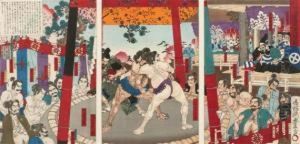Utagawa Toyonobu Paintings
Utagawa Toyonobu was a prominent Japanese ukiyo-e artist, known for his significant contributions to the development of Japanese woodblock printing, particularly during the mid-18th century. Born in 1711, Toyonobu became an influential figure in the Utagawa school, which was one of the most renowned schools of Japanese art at the time, especially noted for its prolific production of ukiyo-e, a genre of woodblock prints and paintings that depicted the 'floating world' of Edo-period Japan (1603-1868). His works are characterized by their dynamic compositions, vivid portrayal of figures, and innovative use of color and line.
Utagawa Toyonobu's artwork often featured scenes from the kabuki theater, sumo wrestling, and the daily life of Edo (modern-day Tokyo), as well as beautiful women (bijin-ga), landscapes, and historical tales. He was adept at capturing the movement and liveliness of his subjects, which set his prints apart from those of his contemporaries. Toyonobu is also credited with pioneering the full-length portrait format in ukiyo-e prints, which would later become a standard format in the genre. His influence extended beyond his lifetime, as he played a crucial role in the development of nishiki-e, or multi-colored woodblock printing, which revolutionized the ukiyo-e genre by allowing artists to produce prints with a wide range of colors.
Despite his significant contributions to the world of Japanese art, Utagawa Toyonobu's works were, for a time, less recognized than those of some of his contemporaries and successors within the Utagawa school, such as Utagawa Hiroshige and Utagawa Kuniyoshi. However, in recent years, there has been a resurgence of interest in his work, with art historians and collectors alike appreciating his role in the evolution of Japanese woodblock printing and his mastery of form and color. Toyonobu passed away in 1785, leaving behind a legacy that has cemented his place among the great masters of ukiyo-e.
